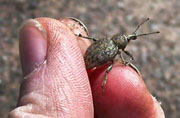 Cornell University entomologist Elson J. Shields and research specialist Antonio M. Testa have written an article on the “Biological Control of Alfalfa Snout Beetle with Persistent Entomopathogenic Nematodes: Expanding a Single Farm’s Success to an Area-Wide Biological Control Program” for the Winter 2017 issue of American Entomologist. The Northern New York Agricultural Development Program is acknowledged for its long-term funding of the research to develop the science of this project.
Cornell University entomologist Elson J. Shields and research specialist Antonio M. Testa have written an article on the “Biological Control of Alfalfa Snout Beetle with Persistent Entomopathogenic Nematodes: Expanding a Single Farm’s Success to an Area-Wide Biological Control Program” for the Winter 2017 issue of American Entomologist. The Northern New York Agricultural Development Program is acknowledged for its long-term funding of the research to develop the science of this project.
The article notes “Alfalfa snout beetle, Otiorhynchus ligustici (L.), (ASB) remains the most serious insect pest impacting alfalfa production in North America.”

Shields and Testa answer the following questions in the illustrated article:
. Can a cost-effective EPN (entomopathogenic nematode) mass-rearing procedure be developed that is both farmer-friendly and low-labor while retaining the genes for persistence?
. Can EPN application rates and techniques be adapted to low-value crops and typical commercial pesticide application equipment? Is timing of application also important?
. What is the best mix of EPN species to successfully attack ASB?
. How well will the adapted persistent EPNs persist across typical soil types and cropping rotations found within the northern New York ASB-infested area?
. Will a single application of EPNs under the inoculative strategy provide enough mortality to ASB populations to reduce population levels to sub-economic?
. Will farmers embrace an area-wide biological control program against ASB utilizing native persistent EPNs even though impact after application may not be seen for two to four years?
. How will the biological program be sustained for the long term? (This section notes the establishment of one nematode-rearing business with room for others to commercially rear, sell and apply the EPNs to continue the battle to manage ASB to protect regional alfalfa crops).
NNYADP ASB Research: Reports, Fact Sheets, Photos, Video
Farm Pest Biocontrol Now Sought Across U.S.: ASB nematode projects are underway or planned in New Mexico, Texas, Ohio and Michigan